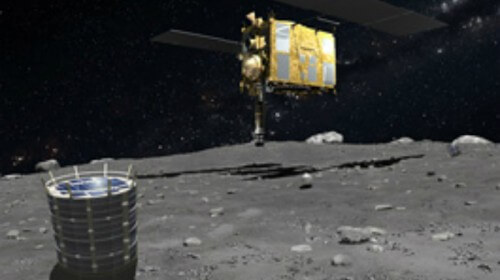A Japanese spacecraft with a German lander and an Israeli computer sets out to explore an asteroid and bring samples to Earth

A few weeks after the European Space Agency succeeded - almost completely - in the operation to land a spacecraft on a comet, the Japanese Space Agency wants to return and prove its technological superiority. After several delays due to weather, the "Hayabusa 2" spacecraft, which is supposed to study an asteroid, was launched this morning. The mission of the Japanese spacecraft is more complex than that of the European agency. It is also supposed to send a lander to the surface of the asteroid, but the lander, which was produced by a German corporation, is supposed to operate there for about a year and a half, and also skip between several sites on the surface of the asteroid. In addition, the mother spacecraft is supposed to bombard the surface of the asteroid with a large metal projectile, and then sample the dust grains that will emerge from the impact site. It is also planned to fly very close to it, again, to collect soil samples. The spacecraft's journey to the asteroid, which meanwhile bears the catchy name 1999JU3, should last 3.5 years. The German lander, Mascot, is expected to operate for a year and a half on the surface, before the mother spacecraft leaves the asteroid, and returns to Earth with the samples at the end of 2020.
The source of life
"Hayabusa", "falcon" in Japanese, was a spacecraft that managed to collect samples from an asteroid and return them to Earth about four years ago, at the end of a journey full of hardships and mishaps. The next generation, "Hyabusa-2", is supposed to land on a smaller asteroid (a ball with a diameter of about 900 m), and of a different type, which is supposed to shed more information about the origins of the Earth. Asteroids, unlike comets, are space rocks that do not contain much ice, so they do not form a tail when they approach the Sun. The scientists believe with this, that the water that was stored in asteroid rocks that collided with the ancient Earth, is the main source of the ocean water that we have today. The study of the asteroid should verify or disprove this theory. Equally important, the asteroids probably brought to the young Earth most of the organic materials that enabled the creation of life on our planet.
The computer is from Mikneam
As with any good space mission, "Hyabusa 2" also has an Israeli component. This time it's the lander's computer, "Mascot", developed at the "Ramon Chips" company in Mikneam. The company manufactures computers for space flights. "Such computers are supposed to be particularly strong and reliable," explains the company's CEO, Prof. Ran Ginosar. "They need to be resistant to the strong radiation in space, withstand extreme temperature changes, and be adapted to heat emission, because in space there is no air cooling like on Earth." It is a fairly small chip, a square of 3 x 3 cm, and 0.5 cm thick. This tiny processor is supposed to manage all the operations of the lander - from landing on the surface of the asteroid and anchoring to the ground, to operating the research instruments. The "Ramon Chips" company, named after the astronaut Ilan Ramon, was established a decade ago, based on knowledge developed at the Technion. This is the first processor it sends into space, and several similar processors are installed in spacecraft and satellites that are supposed to go into space in the coming years, including the Technion's "Samson" project, which includes a fleet of autonomous satellites, and the SpaceIL spacecraft, which a group of young entrepreneurs plans to launch to the moon next year. Now the company, funded by the Ministry of Science, is working on developing a much more powerful and advanced space processor, with the trend that in the future satellites will be able to process a lot of information themselves, and thus will have to transfer less raw information to Earth.

One response
It's a shame that there is no more business with Japan. Maybe the Japanese could build an airport on dry land in Haifa Bay